Core i7 Overclocking
One of the great attractions of the Intel Core i7 is its fantastic overclocking ability. As shown in Overclocking Core i7, the overclocking ability varies by CPU and the chip's onboard memory controller. Still, overclocks of the 2.66GHz 920 chip normally can reach 3.6GHz to 4.0GHz with air-cooling - and even higher with water- and phase-change-cooling.
As discussed in many overclocking articles here, there are normally two types of overclockers. First are those who overclock for value, which are those that select cheaper parts rated at lower specs for their ability to overclock to much higher performance levels. Second, there are overclockers who try to reach the highest overclock possible, and who usually choose the highest priced and higher-performance parts to overclock even further. This Core i7 Overclocking System leans toward the value side of the overclocking equation. Generally parts were selected, like the Core i7 920, because they are a good value that becomes an outstanding value when overclocked. Where an alternative exists that would be a better choice for the "absolute" overclocker it will be pointed out.
| Intel Core i7 Overclocking PC | ||
| Hardware | Component | Price |
| Processor | Intel Core i7 920 Socket 1366 (2.66GHz Quad-core, 4x256KB L2, 8MB L3 Cache) |
$295 |
| Cooling | Thermalright Ultra-120 eXtreme-1366 RT | $75 |
| Video | MSI R4870-T2D1G Radeon HD 4870 1GB | $205 |
| Motherboard | DFI LP UT X58-T3eH8 X58 - Retail | $300 |
| Memory | Kingston HyperX T1 3GB (3x1GB) DDR3-1866 (PC3-14900) Kit KHX14900D3T1K3/3GXR | $159 |
| Hard Drive | Seagate Barracuda 7200.11 ST31000333AS 1TB | $105 |
| Optical Drive | LG 6X BD-R 2X BD-RE 16X DVD+R 6X Blu-ray DVD-ROM SATA Blu-ray Burner GGW-H20LK | $190 |
| Audio | On Board | - |
| Case | Antec Nine Hundred Black Steel ATX Mid Tower | $100 |
| Power Supply | CORSAIR CMPSU-850TX 850W SLI Ready CrossFire Ready 80+ Certified | $130 |
| Display | ASUS VW246H Black 24" 2ms (GTG) HDMI 1080P | $290 |
| Speakers | Logitech G51 155W RMS 5.1 Speakers - Retail | $90 |
| Keyboard | Logitech G11 USB Gaming Keyboard | $59 |
| Mouse | Logitech MX518 8-Button/1 Wheel USB 1800dpi Laser Mouse | $40 |
| Operating System | Microsoft Vista Home Premium OEM | $99 |
| Bottom Line | $2137 | |
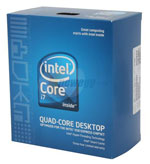 |
The i7 920 is the lowest priced Intel Core i7 you can currently buy. It is normally the choice for overclockers because it can reach as high as 4.0GHz with air-cooling if you are lucky enough to find one with a strong on-chip memory controller. Even those that don't reach the top normally make it to 3.6GHz without too much effort. That represents a huge performance boost for an entry-level part - even a high-end "entry" CPU.
In our look at overclocking in the Phenom II Launch review, the Core i7 920 reached as high as 3.8GHz at stock voltage and 4.0 GHz when overvolted to 1.35V. That is a 50% overclock. You start with a processor that is 30% faster in some tests compared to a Core 2 or Phenom II, and then you find you can also overclock this 2.66GHz CPU to 3.8GHz to 4GHz with careful tweaking and better cooling. You will certainly be very happy with Core i7 base performance, but in overclocking you will be ecstatic with this CPU.
The one drawback of the 920 is the locked 20X multiplier. Overclocking can only be achieved by increasing the "bus" speed (there really is no "bus speed" in the i7 design). The only Core i7 with an unlocked multiplier is the Core i7 965. That processor is an excellent choice if you prefer the multiplier route to overclocking or if you want the multiplier available as one of the variable OC parameters. However, be prepared for a significant increase in price. The Core i7 965 street price is around $1000.
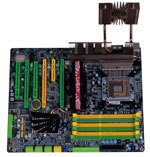 |
The DFI LP UT X58-T3eH8 LGA 1366 is the best overclocking socket 1366 motherboard we have tested so far. DFI is a motherboard name with a long history of overclocking champions, and the new LAN Party UT X58 will not disappoint. Recent DFI boards have been some of the best overclocking designs we have seen from DFI. The company hired some engineers from the old Abit and their influence is certainly seen in recent designs. The DFI X58-T3eH8 is also compatible with either CrossFire or SLI, which provides great flexibility in selecting a GPU. The entry i7 Gigabyte GA-EX58-UD3R is a superb motherboard, but it is CrossFire only. That is not really an issue if you select an AMD video card, but it does somewhat limit choices for future expansion. With both CrossFire and SLI compatibility, the DFI can go wherever the GPU market leads and still support future expansion to multiple GPUs.
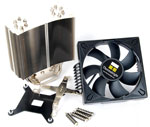 |
Several well-known coolers offer optional adapters for socket 1366, but the cooler choice to mate with the DFI X58 board for overclocking is the Thermalright Ultra-120 eXtreme-1366 RT. This is basically the top performing Thermalright Ultra-120 eXtreme from our Core 2 tests combined with a socket 1366 adapter and an included quiet high-performance 120mm fan. There are several socket 1366 coolers in the lab for testing and we will have more to say about their performance in the next few weeks. The Thermalright socket 1366 is a good choice for Core i7 overclocking.
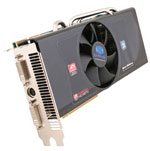 |
It is very difficult to recommend an NVIDIA GTX 285, or even the GTX 280, when the similar performing Radeon 4870 1GB is available for $135 less at $205. Our choice for the GPU is the MSI R4870-T2D1G Radeon HD 4870 1GB, which is the same card used in our Core i7 Entry System. The NVIDIA GTX 280 and GTX 285 are excellent alternatives if you can handle the 50% higher price or if the prices drop. We actually still prefer the performance of the NVIDIA cards on Core i7, but the price difference is hard to swallow.
Memory for overclocking the Core i7 needs to have a very wide operating range to keep up with the higher "bus" speeds needed to overclock the i7 920. The highest speed production memory you can currently buy, with performance warranted at rated speed, are the DDR3-2000 3GB kits. Right now the 3GB memory kits are also better at the higher speeds than 6GB triple-channel kits. That will be changing soon, however, as higher speed 6GB kits are starting to make their way to market.
 |
Our selection is close to the highest speed available with the top-performing Kingston HyperX T1 3GB (3x1GB) DDR3-1866 (PC3-14900) triple channel kit. You are guaranteed a latitude to DDR3-1866 above the normal speed of DDR3-1333. You can also dial down the base speed to 1066 to squeeze even more range from the memory. Kingston normally rates their HyperX memory conservatively and it is likely to perform even better than rated. If you want the fastest 3GB kit you can buy you can choose the 3GB DDR3-2000 kit from G.Skill or the hard to find DDR3-2000 kit produced by Kingston. The Mushkin DDR3-1600 kit used in the Dream i7 system is also a good choice because of the very fast rated timings of 7-8-7 at DDR3-1600 in a 6GB memory kit instead of the 3GB we chose for this i7 OC system.
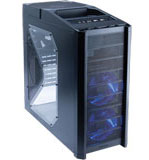 |
The case receives an upgrade with the selection of the well-regarded Antec Nine Hundred which bottom mounts the power supply and provides plenty of internal storage. Cooling is provided by 120mm fans and a massive 200mm top exhaust fan. The Nine Hundred is a great choice for an overclocking case that will use air-cooling. There is also the upgrade Nine Hundred Two for about $50 more.
 |
An overclocking power supply for the Core i7 needs plenty of reserve power provided by a conservative design with solid build quality. The 850W Corsair CMPSU-850TX should be able to handle whatever you want to do with this i7 system. It is 80 Plus certified and provides 12V power on a single rail. There is also the fact that Corsair has a reputation for conservatively rating their power supplies, which means this 850W should be as good as many other 1000W power supplies. That makes the 850TX a great value at just $140 after rebate.
An SSD (Solid State Drive) would be a great addition for a boot drive and/or game drive in this Core i7 OC system. The problem is we don't yet know which SSD to recommend. AnandTech is in the process of testing the latest generation of cheaper SATA II designs, but until this is complete it would be impossible to recommend any SSD other than the expensive Intel 80GB and 160GB SSDs. In our previous tests, the earlier SSDs were plagued with data corruption issues as the drive neared capacity and with annoying random pauses that were particularly troublesome in gaming. Anand is in the process as this goes to press of evaluating new SSDs for an upcoming review. Be sure to look for his SSD roundup and recommendations for an SSD. I have been using a very reasonable G.Skill 64GB SATA II SSD with good results for several weeks. The SSD is just $129 and the entire Windows 7 beta system with all drivers occupies just 30GB of the 64GB available. My subjective experience has been good, but this is one of the drives included in the SSD roundup where it will be tested in a more systematic manner.
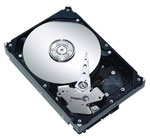 |
Our storage drive selection for the Core i7 Overclocking system is the Seagate Barracuda 1TB drive (1000GB). While the Seagate 1.5TB drive and the early 1.0TB drive were plagued with firmware problems at their release, the performance and reliability of this later 1TB Seagate has been excellent in our testing so far. For a price of around $100 the value is incredible. While there are differences between hard drives, outside of running benchmarks most people aren't likely to notice the difference in performance between Western Digital, Seagate, Samsung, Hitachi, and other major brands. All are worthy of consideration if the price per gigabyte (or terabyte) is right.
 |
We feel the optical drive for the Core i7 OC system needs to both play Blu-ray disks and burn 25GB/50GB Blu-ray discs. We have upgraded the optical drive to the flexible LG GGW-H20LK burner, which is now selling for just $190 and has the ability to both read and write Blu-ray disks. It also can burn DVDs at 16x speed in single or dual-layer formats.
The onboard audio solution is adequate for most of today's computer users. That is why we stuck with the onboard audio on the DFI. This also removes one more overclocking variable in that it is easy to turn off onboard audio if for some reason it becomes an impediment to overclocking. If you are heavily invested in game titles that do best on a Sound Blaster card, you might consider a Creative Labs sound card. If you gravitate toward audiophile quality, the ASUS Xonar 1.1 is a good upgrade.
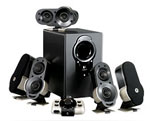 |
Speakers have been upgraded to the Logitech G51 155W RMS 5.1 surround sound speakers. They are selling for $90 after a $40 rebate, which is a great value on these well-regarded powered speakers.
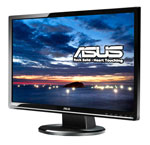 |
The LCD display resolution is the same 1080p HD resolution chosen for the value midrange systems; the size of the monitor however is increased to 24" so everything on screen is just a little larger. The ASUS VW246H 24" 2ms (GTG) HDMI provides the preferred DVI and HDMI inputs, as well as an analog VGA port. Panel speed is rated at 2ms, but we have found most current LCD panels perform similarly and the speed rating does not really guarantee very much. The ASUS monitor provides a sharp image, good colors, and fast panel speed at a very good price of $290. For more information on what matters in a monitor and how to read LCD specifications take a look at our Holiday 2008 Display Guide.
It is worth pointing out that all the LCD monitors from the new class of 21.5" full 1080p to the large 28" monitors all feature resolutions of 1920x1200 or 1920x1080. Older 22" monitors are 1680x1050. The point here is that for higher resolution - higher than 1920 horizontal resolution that is - the next step in monitors is the 30" 2560x1600 displays. Moving up to a 26"-28" LCD gives bigger pixels, not a higher resolution. (Yes, there are also a few 23" LCDs with a slightly higher 16:9 resolution, like the Dell SP2309w, but 2048x1152 isn't a huge step up.) Also note that nearly all new 21" to 28" LCDs are using TN panels instead of S-PVA or S-IPS, particularly the inexpensive options. There's a reason some 24" LCDs still cost over $500.
The Bottom Line for the Core i7 Overclocking System is $2137 for the complete system. We are confident that with a little effort you can overclock this system to 3.6GHz to 4.0GHz on air-cooling. Of course, we could never guarantee that result as components do vary in their capabilities, but you should have every expectation that this Core i7 OC System can easily perform at levels higher than the $1010 Core i7 965, which is specified at 3.2GHz.










106 Comments
View All Comments
Wesley Fink - Thursday, February 5, 2009 - link
The $1000 to $2000 Guide was published 1/12/2009. At that point the best ATI drivers with the Core i7 were a special beta set of 8.12 drivers. On 1/29/2009 ATI released the 9.1 drivers, which are much better with the ATI cards on the Core i7 than earlier drivers.Our issues before were the ATI drivers and not the cards. We explained in today's guide that the ATI drivers were headed in the right direction and we could no longer ignore the better value of the 4870 1GB.
cajones - Thursday, February 5, 2009 - link
So three weeks ago in the $1000-$2000 buyers guide, it was stated to stay away from the ATI cards on X58 systems due to problems. So last night I bought a system with a Nvidia GTX 260 (55nm). Now I see the board of choice with X58 in this guide is the 4870! What changed?Gary Key - Thursday, February 5, 2009 - link
I run the GTX260 216 in my personal systems even though I have a couple of HD 4870s laying on the floor right now that I purchased for our Phenom II comparison articles. If it were not for the recent price drop and improvement in drivers, I would not have even considered the HD 4870 1GB as an option. However, all of us on the staff agree it must be seriously considered now. At the same time, we all agree the GTX260 216 is still a great card, just the cost/benefits ratio has changed significantly this last week. The short story is that you cannot go wrong with either card. :)JarredWalton - Thursday, February 5, 2009 - link
Newer drivers have helped, but honestly you don't have to feel bad about the GTX 260 - it's really something of a toss-up. I have a 4870X2, but honestly I wish I had waiting for the GTX 295 instead. CrossFire still doesn't live up to its potential in games more often than not, and without profiles you're stuck waiting for hacks or new drivers - usually 2-3 months after a game is released, unless it's a major title like Far Cry 2. Funny enough, Fallout 3 seems a major title and it still isn't properly CF enabled.shatteredstone - Thursday, February 5, 2009 - link
You mention that the ASUS P6T6 Revolution (btw, there is a typo in the article (P5T6)) would be the optimal board for Triple-SLI. As somebody who is seriously considering going that route in the near future, I will have to disagree.With three two-slot graphics cards, you will be constrained to using onboard-audio -- all 6 slots are used/unusable, and there is no 1-lane PCIe slot to accomodate the audio solution. The Asus II Rampage Extreme supports triple-SLI as well, but actually offers such a slot (it comes with their custom X-Fi, but you can use a Titanium or the recommended card here as well -- although you may have to remove 3-4 fins from one of the passive chipset coolers; if you are going to go with watercooling, this is naturally not a problem).
Furthermore, "fastest triple-SLI setup possible" should be taken with a grain of salt. It is true that the 3 PCIe slots will all be x16, but that does not necessarily make this the fastest possible solution. Two of those three slots will terminate in the NF200, which will combine those 32 lanes to 16 which can actually reach the CPU (and therefore main memory); furthermore, only the communication between the two cards terminating in the nf200 will actually be able to communicate with eachother at x16 bandwidth; connectivity with the third card will still be constrained by the single x16-connection from the NF200 to the X58.
In essence this means that this setup will only really have benefits if your application is constrained by two of the three cards talking to eachother. Available bandwidth to memory remains about the same (assuming you actually utilize the cards in parallel, otherwise you really don't need three of em on there anyway). I would also not be surprised if the NF200 introduces some latency into the whole thing, and I would be thoroughly surprised if you could see the difference in today's GPU-killer games (Crysis, say).
One other nitpick would be the choice of Vista Ultimate OEM instead of Vista Ultimate FPP. Since this is the dream system, it may see a lot of tinkering over the years; I am not 100% current on the US-American license terms for Vista Ultimate, though from what I understand, your OEM version will be tied to that one computer (or whatever Microsoft may deem that to mean), while you can legally transfer the FPP from one computer to another (though you might have to call them to get it activated, anyway).
One other nitpick : in the article, you link to the p6t6 on newegg (as well as one or two other things). I did not look at the link before opening it in the background, so it was quite counterintuitive to find it bringin me to NewEgg instead of a review or content on Anandtech (especially since most of the other components are /not/ linked that way, and there is no indication of this link actually just directing you to a store).
Thanks for the guide; My dream system is close (currently thinking of the rampage ii extreme instead of the p6t6, even though I really couldn't care less about those onboard buttons and LEDs; probably some higher speed memory (if it is at all available; the nice-looking ocz blade 2kmhz/cl7 kits look lovely on paper but probably will never ever reach the retail channel), water cooling for most of this stuff (been meaning to play with that for a while), gtx285 instead of 295 (the memory does it for me), and some as-yet undecided storage decisions.
Gary Key - Thursday, February 5, 2009 - link
If you want to run triple SLI and retain a half slot (without mods), then the Rampage Extreme II is a better choice or the upcoming EVGA Classified. Personally I would never run triple SLI for any reason except trying to get a good 3DMark. Even then you would need LN2 and a hand picked i7 from Intel to have a possibility in being near the top of the Orb. 3 way-SLI is just not worth the hassle and cost, same goes for tri-Crossfire.I suggested this board to Wes since it is now rock solid. I prefer workstation level quality in my main home system and this board offers it. It took a few BIOS releases to get there, but this board does offer the ability to overclock with lower voltage, VTT, and VDimm rates than the other boards we have tested, with the exception of the DFI UT board in the overclocking section.
Yes, the NF200 on-board does not guarantee "the fastest SLI" setup possible, but it does not hurt that much either and you know this board will never have any driver or BIOS incompatibilities with SLI. It is just another assurance that you pay for going this route.
Overall, I think Wes went with this board in the Dream System more for the quality and features of the board than worrying about gaming or pure overclocking performance. If you wanted to save some money, there are other options like the ASUS P6T Deluxe, Gigabyte UD5, or the EVGA X58 SLI for feature rich boards that over a great overclocking experience.
If overclocking is not at the top of your list, the MSI Eclipse X58 has turned into a really balanced board as of late. Down the ladder there is the Asus P6T, DFI DK X58, and MSI Platinum SLI that still offer SLI and very good quality/performance metrics.
Wesley Fink - Thursday, February 5, 2009 - link
Unfortunately spelling and grammar checks do not catch incorrect model numbers. We got it right 3 of the 4 times and the incorrect 4th reference is now corrected.Gary Key is our Motherboard Editor and he very passionate about the P6T6 WS Revolution. I have linked him to your comment.
tretchie - Thursday, February 5, 2009 - link
I don't think the LG GGW-H20LK mentioned in this article can burn 50GB BD-RE discs as claimed by the author. I think it is limited to 25GB BD-RE discs. Can someone in the know comment on this?Wesley Fink - Monday, February 9, 2009 - link
The LG burner supports writing double-layer (50GB) Blu-Ray disks. I have burned a 50GB with the LG in my own system.iregulate - Thursday, February 5, 2009 - link
I can verify that it does burn DL BD-RE discs.